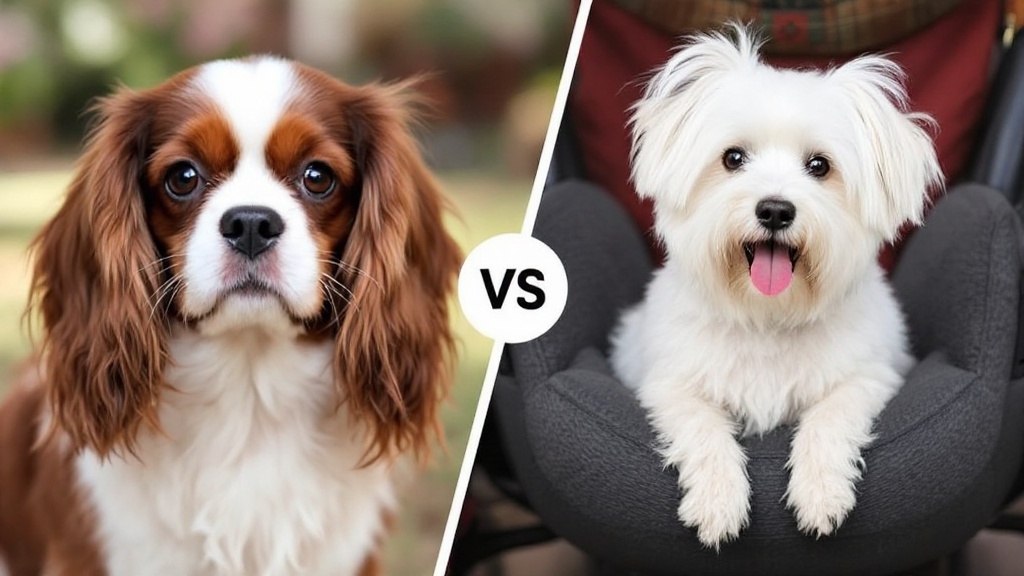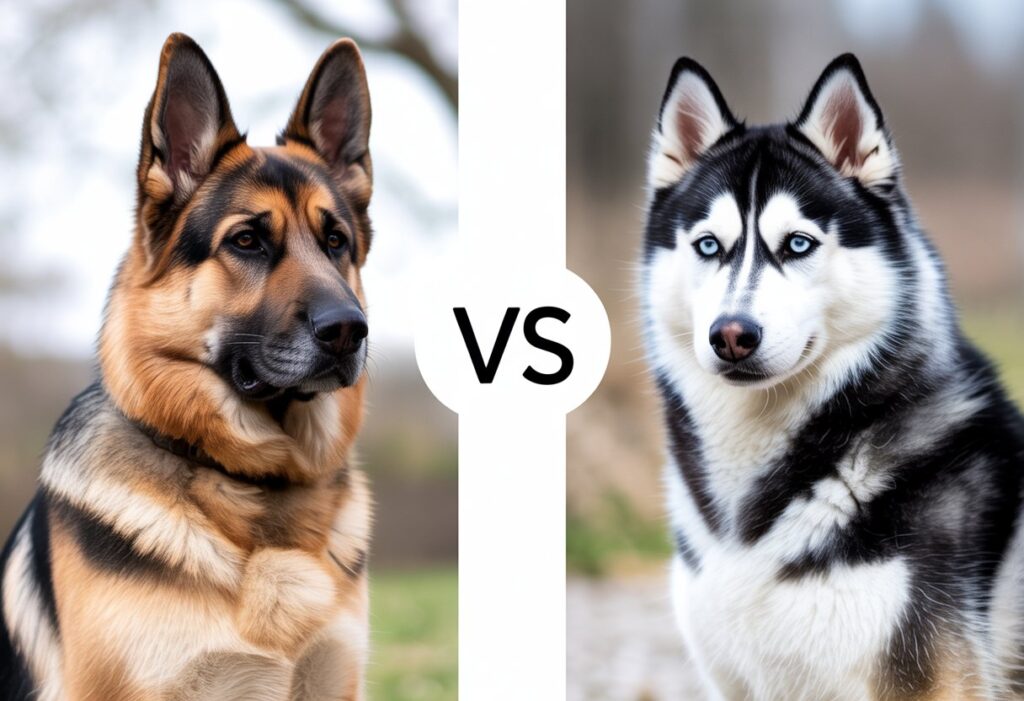Choosing between a Cavalier King Charles Spaniel and a West Highland White Terrier isn’t easy if you’re hoping for a friendly, loving dog at home. Both breeds are small and make good companions, but their personalities and care needs aren’t exactly the same.
Knowing what sets them apart helps you figure out which dog fits your lifestyle better.
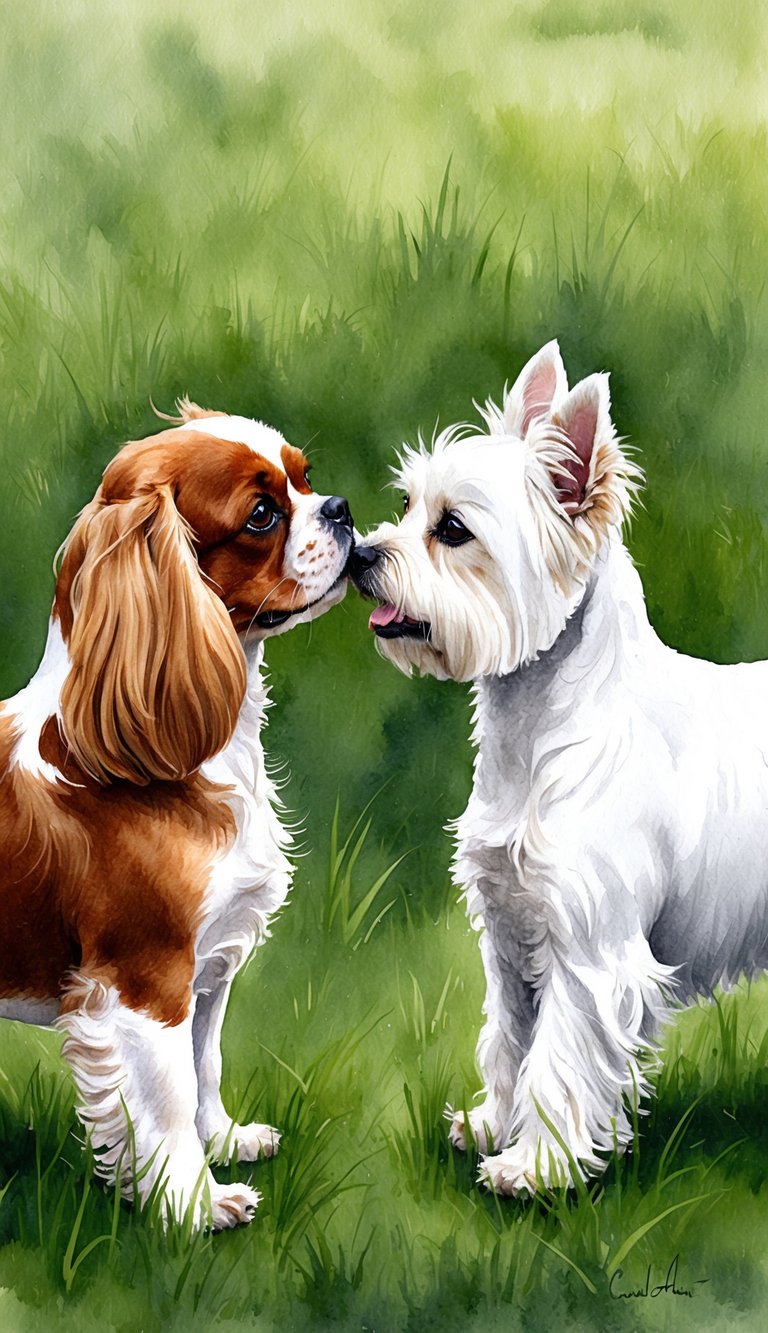
Maybe you’re wondering which breed is easier to train, needs less grooming, or gets along best with children. Whether you’re in a tiny apartment or a house with a backyard, understanding what each breed is like can really help you find your match.
Breed Overview and Origins
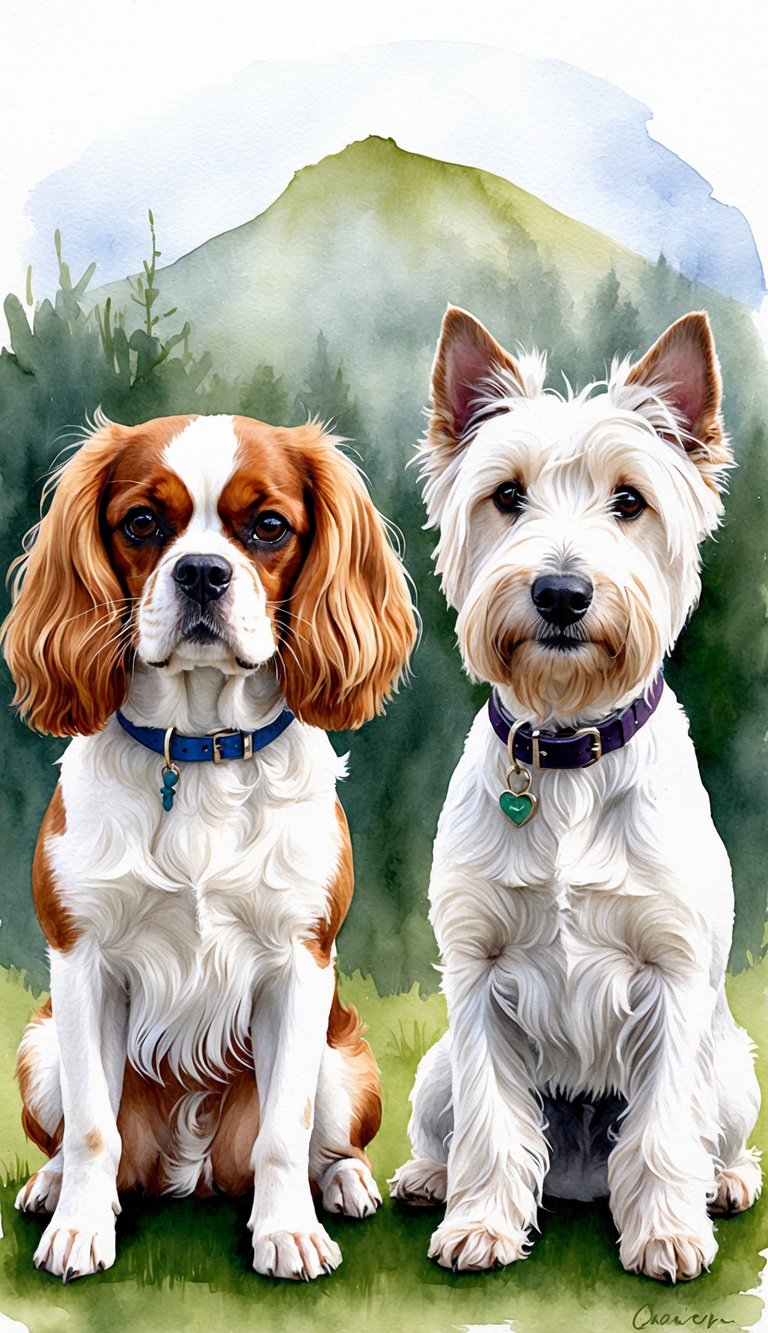
The Cavalier King Charles Spaniel and the West Highland White Terrier have pretty different backgrounds and purposes. Their origins shaped their looks, temperaments, and the roles they play in families now.
History of the Cavalier King Charles Spaniel
The Cavalier King Charles Spaniel comes from England as a small companion dog. Its roots go all the way back to toy spaniels in 16th-century royal courts, especially when King Charles II was around.
People loved these dogs for their gentle nature and elegant looks.
You’d see them in paintings from that era, usually curled up with English nobility or even sleeping in their owners’ beds. The breed almost vanished for a while when people started preferring flatter-faced spaniels, but some dedicated breeders in the 20th century brought the old style back.
Today’s Cavalier stands out with its long ears, soft eyes, and graceful body. It’s still one of the most popular lap dogs, mostly because of its friendly personality.
Origins of the West Highland White Terrier
The West Highland White Terrier, or “Westie,” comes from Scotland. Breeders in the 1800s wanted a tough little dog to hunt rats and foxes on farms.
They crossed local terriers to get a determined dog with a white coat that stood out in the field.
Colonel Edward Donald Malcolm played a big part in shaping the breed. He chose only the white puppies to continue his line, so the dogs wouldn’t be mistaken for prey during hunts. Westies became popular as both hunters and family pets.
You’ll spot a Westie by its sturdy body, white double coat, and lively attitude. They’re known for being bold, loyal, and pretty good with families.
Recognition by the American Kennel Club
The American Kennel Club (AKC) is a big deal in the U.S. when it comes to dog breeds. The Cavalier King Charles Spaniel got official AKC recognition in 1995, so you’ll see them at dog shows and in homes across the country.
The West Highland White Terrier joined the AKC much earlier, in 1908. Westies belong to the Terrier Group, while Cavaliers are in the Toy Group.
Both breeds can compete in AKC events like obedience and agility. Registering your dog also connects you to AKC resources and support.
Physical Characteristics and Appearance

Cavalier King Charles Spaniels and West Highland White Terriers (Westies) look pretty different. Their size, body shape, coats, and features are easy to tell apart once you know what to look for.
Size and Build Differences
The Cavalier King Charles Spaniel is a toy breed with a gentle, graceful frame. Adults weigh about 13–18 pounds (5.9–8.2 kg) and stand 12–13 inches tall at the shoulder.
They have a slender body, a rounded chest, and long, feathered legs.
West Highland White Terriers are small terriers, usually weighing 15–20 pounds (6.8–9.1 kg) and standing 10–11 inches tall. Westies look more muscular and sturdy, with short, strong legs that were built for digging.
Spaniels come off as delicate and refined. Westies, on the other hand, have a lively, robust look.
Coat Type and Colors
Cavalier King Charles Spaniels sport a silky, medium-length coat. Their hair can be straight or a bit wavy and needs regular brushing.
They come in several classic colors:
- Blenheim (chestnut and white)
- Tricolor (black, white, and tan)
- Ruby (solid chestnut)
- Black and tan
West Highland White Terriers have a double coat. The top layer is straight and harsh, while the undercoat is soft and dense.
As you’d guess from the name, Westies are always pure white. Their coat needs regular grooming and, ideally, hand-stripping to keep its texture sharp.
So, Cavaliers have a bunch of color options, but Westies are always white with a thicker, rougher coat.
Distinctive Features
Cavalier King Charles Spaniels have those big, round, dark eyes and a sweet, gentle face. Their long, feathered ears frame their head, and their muzzle is short and slightly tapered.
Westies have a pointier face, a black nose, and dark almond-shaped eyes. Their ears stand upright and look triangular. They also have strong jaws and a fluffy tail that sticks up like a carrot.
If you put the two breeds side by side, you’ll notice the different head shapes, ear styles, and overall vibe. It’s not hard to tell them apart from other small breeds, either.
Temperament and Personality Traits
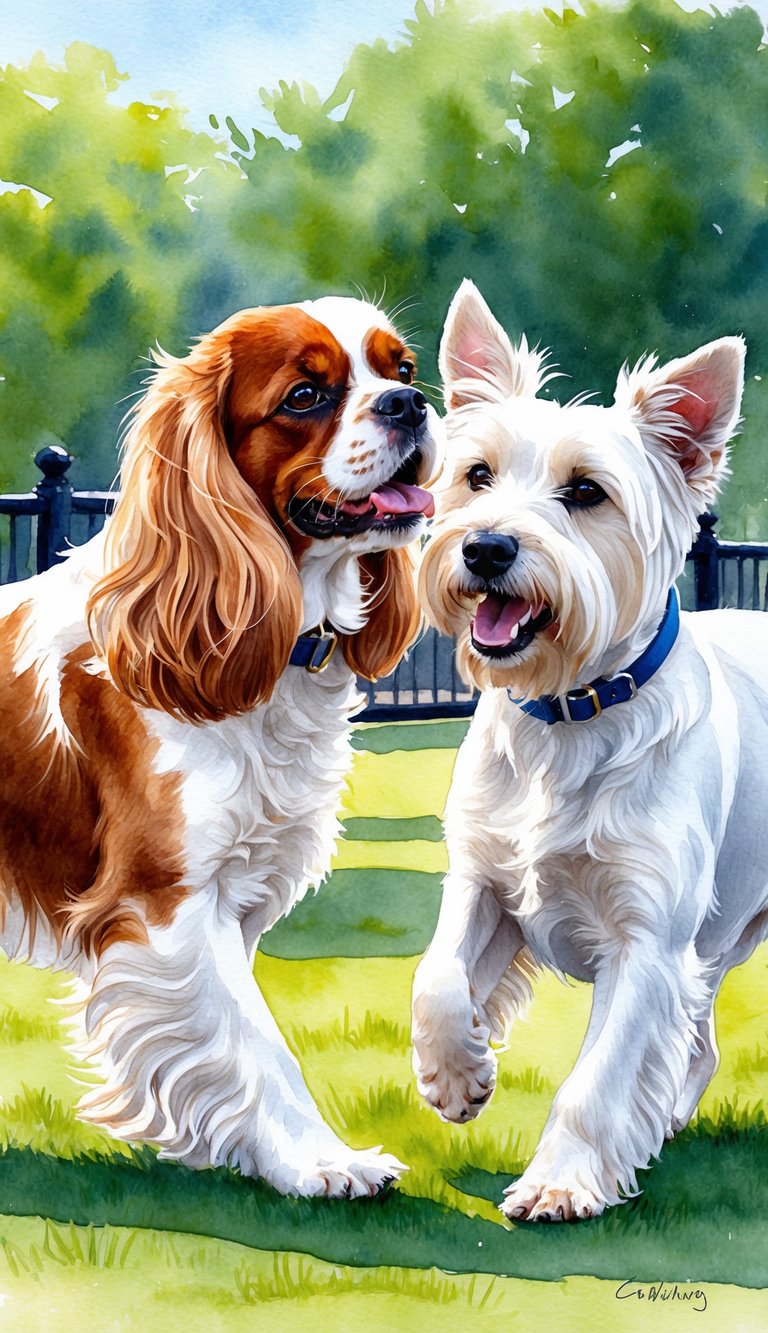
The Cavalier King Charles Spaniel and West Highland White Terrier have some clear personality differences. These quirks affect their behavior, social lives, and how they fit in different homes.
Typical Behavior of Cavaliers
Cavalier King Charles Spaniels are usually friendly and affectionate. They love being close to their people and will happily snuggle on your lap.
They get along well with other pets and kids. With their gentle nature, they pick up on positive training pretty fast.
Cavaliers don’t like being left alone for long stretches—they can get anxious or sad.
Some common Cavalier traits:
- Very social and trusting
- Gentle, eager to please
- Adaptable to calm or busy homes
If you want a dog that enjoys downtime indoors but still likes walks and play, a Cavalier is a solid pick. They tend to mirror the mood of the household, almost like little furry empaths.
Temperament of Westies
West Highland White Terriers (Westies) are lively, bold, and always up for something new. They’re confident and love to explore.
Westies have a strong prey drive, so don’t be surprised if they chase squirrels or smaller pets outside. They’re alert and will bark at unfamiliar sounds or people.
Key Westie traits:
- Feisty, energetic
- Loyal, but can be stubborn
- Enjoy games and problem-solving
If you want a dog that’s alert and doesn’t mind alone time, Westies might be your speed. They need clear direction but can learn quickly with firm, fair training.
Suitability as Family Pets
Both breeds can make great family pets, but their personalities suit different situations.
Cavaliers are usually best for families who want a gentle dog that’s good with kids and visitors. They’re happy in multi-pet homes and love attention.
Westies are perfect for families who want a playful, lively companion. They’re fine with children, but their boldness and energy mean they might do better with older kids. Westies can handle apartment life or a house—just give them daily walks and something to do.
Quick comparison:
| Breed | Calm Indoors | Needs Exercise | Good with Kids | Social with Pets |
|---|---|---|---|---|
| Cavalier | Yes | Moderate | Yes | Yes |
| Westie | No | High | Sometimes | Sometimes |
It’s all about finding the right match for your lifestyle.
Exercise and Activity Needs
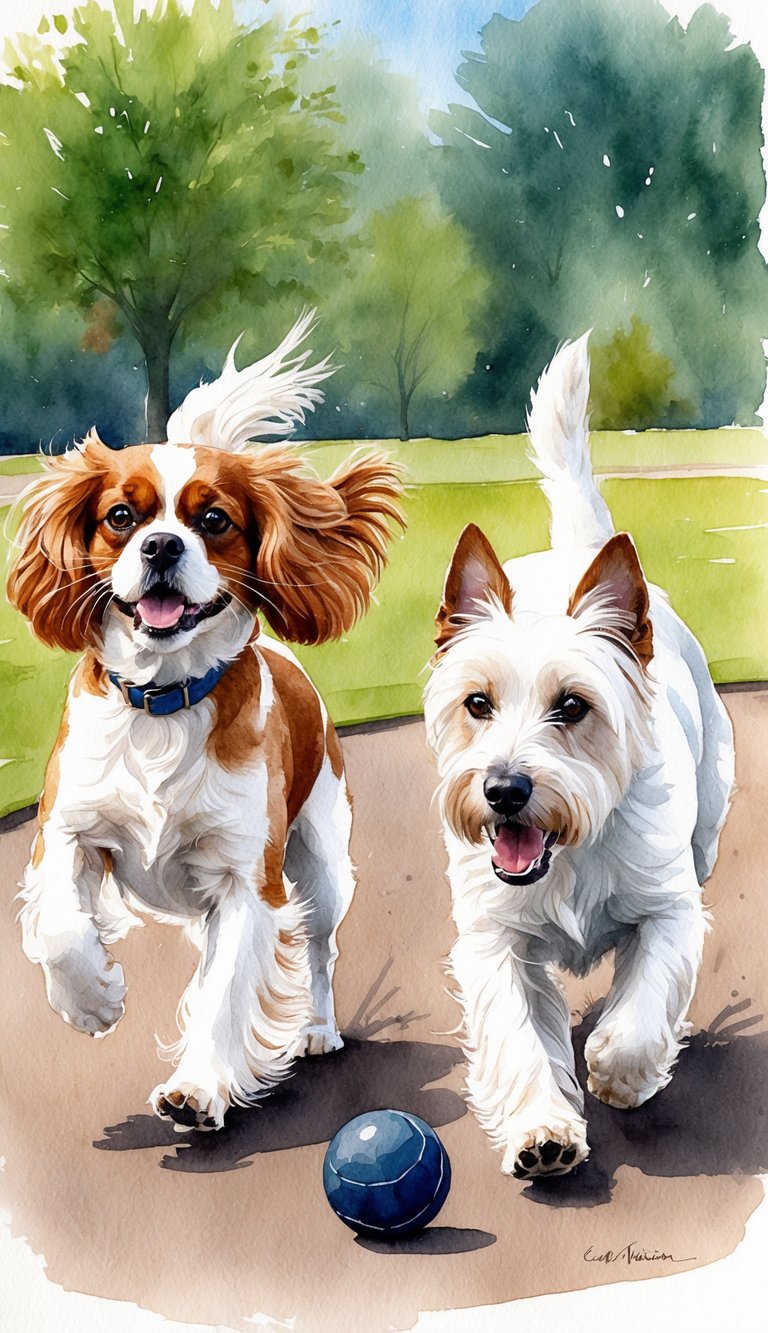
Cavalier King Charles Spaniels and West Highland White Terriers both need daily exercise, but their energy levels and play styles aren’t quite the same. Knowing this helps you keep your dog happy and out of trouble.
Daily Exercise Requirements
Cavalier King Charles Spaniels are happy with moderate activity. Aim for about 30–60 minutes of exercise a day—walks, short hikes, or a game of fetch work well.
They’re toy spaniels, so they do fine in apartments or houses, as long as you meet their exercise needs.
West Highland White Terriers (Westies) need a bit more action. Plan for at least 45–60 minutes of exercise daily.
Westies have a strong urge to explore and dig, so leash walks, supervised yard time, and interactive games are all great.
Some quick tips:
- Keep walks regular.
- Use safe toys for play.
- Watch out for overheating, especially on hot days.
Playfulness and Energy Levels
Cavaliers are playful, but their energy is more gentle. They love games but can tire out quickly, especially if it’s warm.
You’ll often find them napping after playtime.
Westies have more stamina and curiosity. They might chase critters or dig if they get bored. Unlike Cavaliers, Westies can stay active for longer stretches and need a bit more to wear them out.
Here’s a quick look:
| Breed | Playfulness | Energy Level | Fatigue Point |
|---|---|---|---|
| Cavalier | Moderate | Gentle | Slower |
| Westie | High | High | Later |
Give both breeds safe ways to burn off energy, indoors or outside. Problem-solving games like treat puzzles are a smart addition, too.
Grooming and Maintenance
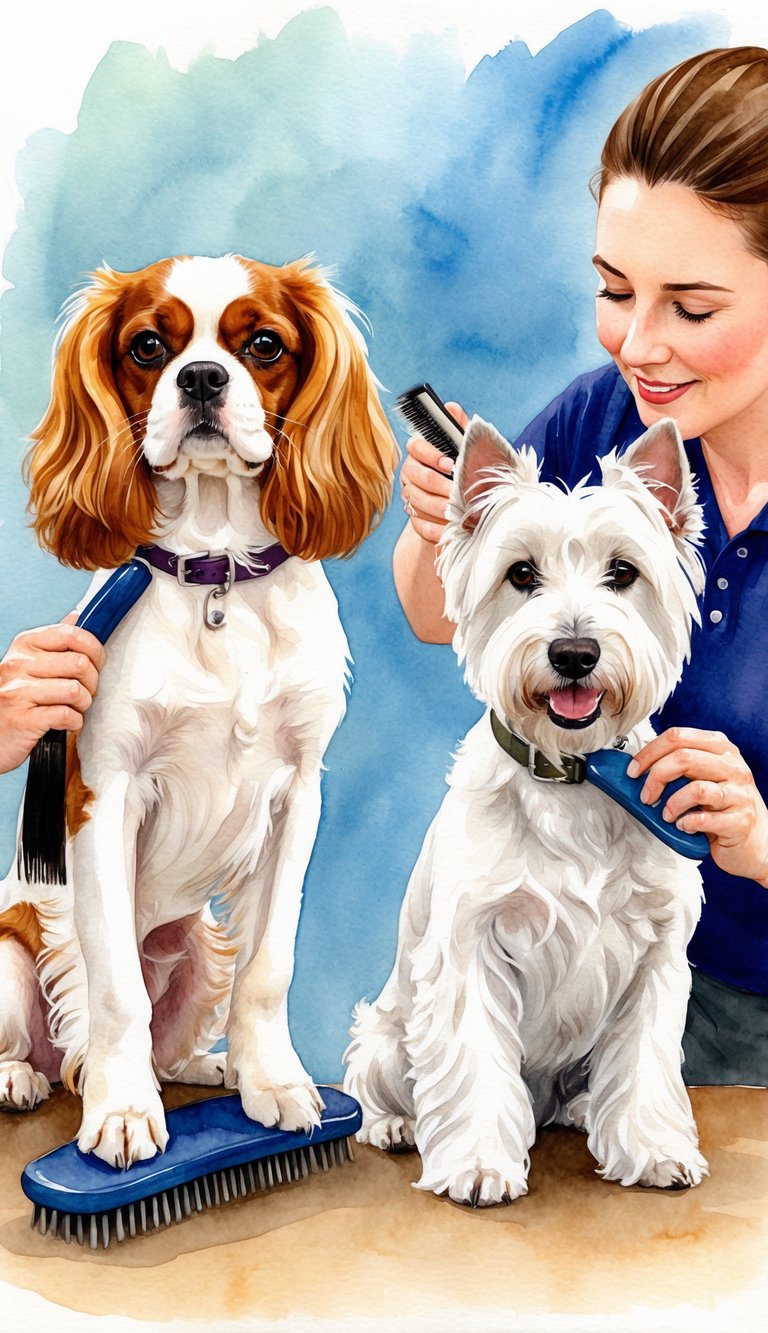
Cavalier King Charles Spaniels have long, silky fur that needs regular brushing and a little extra attention. West Highland White Terriers (Westies) come with a thick, double coat that really benefits from routine care to keep it looking sharp.
Brushing and Shedding
Cavalier King Charles Spaniels need brushing at least three or four times a week. Their long, feathery hair tangles easily, especially around the ears and legs.
Daily brushing keeps their coat shiny and helps avoid mats. It takes a little time, but it’s worth it if you want them looking their best.
Westies have a short, coarse outer coat and a soft undercoat. You can brush them once or twice a week—simple enough.
Their fur traps dirt, but it doesn’t tangle as much as a Cavalier’s. Westies shed very little, so you’ll deal with less hair on your furniture.
Brushing Guide:
| Breed | Brushing Frequency | Shedding Level |
|---|---|---|
| Cavalier King Charles Spaniel | 3-4 times a week | Moderate |
| West Highland White Terrier | 1-2 times a week | Low |
Use a slicker brush for Cavaliers. For Westies, a pin or bristle brush works well.
Bathing and General Care
Cavalier King Charles Spaniels need a bath about once a month, or whenever they get especially dirty. Use a gentle dog shampoo to avoid irritating their skin.
Check their ears often for wax or dirt—floppy ears can trap moisture, and nobody wants an ear infection. Westies can go longer between baths, maybe every 6–8 weeks.
Their skin can be sensitive, so stick with a mild shampoo made for terriers. Trim their nails every month and clean their ears regularly.
Both breeds need their teeth brushed several times a week to keep plaque away. Cavaliers sometimes need extra trimming around the feet and ears.
Westies do best with hand-stripping or careful clipping to keep their signature look.
Health and Lifespan
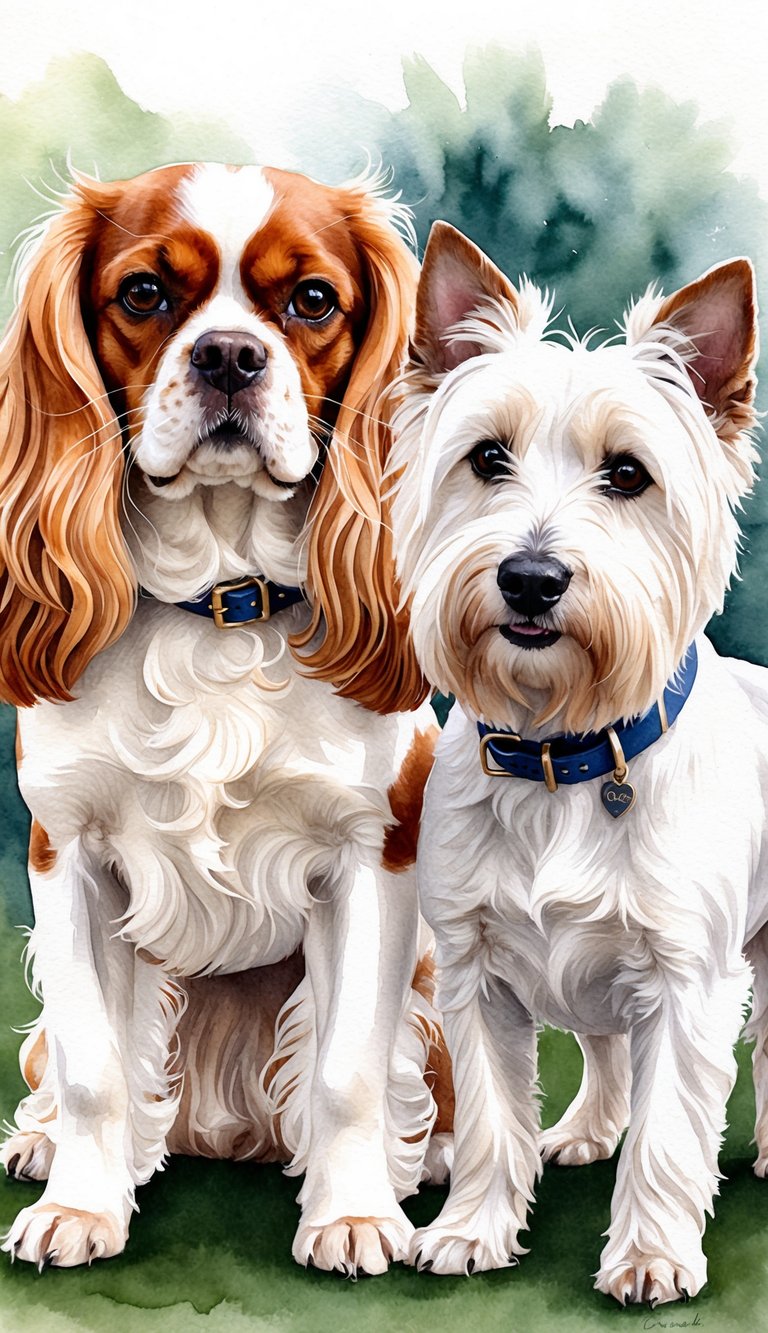
Both Cavalier King Charles Spaniels and West Highland White Terriers face some health problems that can affect their lives. They tend to live between 12 and 16 years, but certain diseases can really impact their quality of life.
Common Health Issues in Cavaliers
Cavalier King Charles Spaniels have a reputation for being sweet, but they’re prone to some serious health conditions. Mitral valve disease (MVD) is a big one—it affects the heart and can lead to heart failure, often showing up when they’re still young.
They’re also at risk for syringomyelia (SM), a painful brain and spine condition. Long ears make them prone to ear infections, and eye problems like cataracts or retinal issues aren’t uncommon.
Obesity can sneak up on them, making heart and joint problems worse. Regular vet visits and managing their weight are important.
Frequent Health Concerns in Westies
West Highland White Terriers are tough little dogs but have their own health risks. Skin problems, especially allergies and atopic dermatitis, come up a lot.
Their white coat and sensitive skin mean you’ll need to keep an eye out for itching or redness. Westies sometimes develop Legg-Calvé-Perthes disease, which affects the hip joint, or craniomandibular osteopathy (CMO), a rare jaw issue mostly in puppies.
Other issues include patellar luxation (those kneecaps can slip) and deafness. Spotting symptoms early and getting treatment helps keep them comfortable.
Expected Lifespan Comparison
Cavalier King Charles Spaniels usually live around 12 to 15 years. Heart disease, especially mitral valve disease, is the main thing that can cut their lives short.
West Highland White Terriers often reach 12 to 16 years, sometimes more if they avoid the bigger health issues. They tend to outlive Cavaliers by a bit.
Here’s a table for a quick comparison:
| Breed | Average Lifespan | Major Health Risks |
|---|---|---|
| Cavalier King Charles Spaniel | 12–15 years | Heart disease, syringomyelia, eye problems, ear infections |
| West Highland White Terrier | 12–16 years | Skin problems, hip disease, patellar luxation, deafness |
Trainability and Intelligence
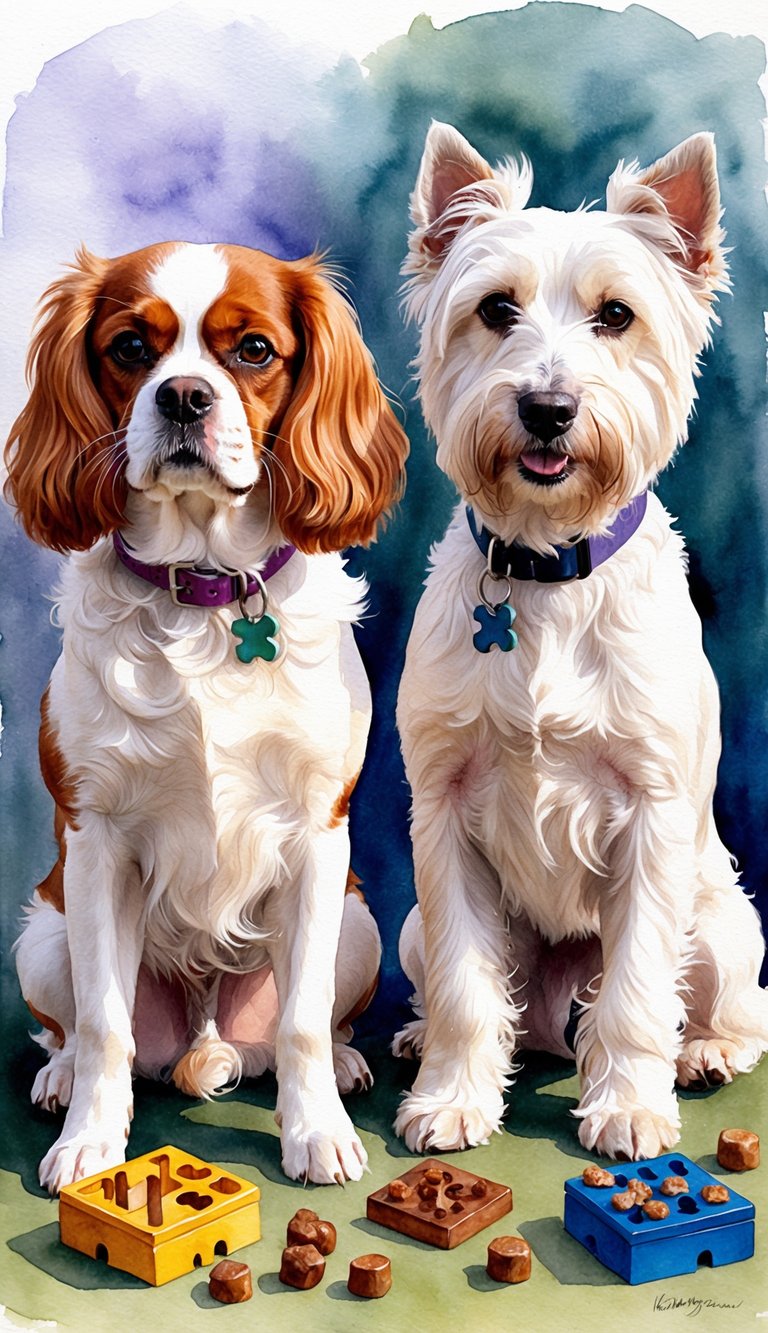
Cavalier King Charles Spaniels and West Highland White Terriers both learn new things, but their learning styles are pretty different. Knowing what motivates them makes training a lot easier.
Learning Ability
Cavaliers want to make you happy and respond well to positive feedback. They pick up simple commands quickly; they’re not Border Collies, but you don’t have to repeat yourself forever either.
Westies are smart but can be stubborn. They’ll learn basic cues if you’re consistent, but sometimes they’ll test your patience.
Short training sessions and clear signals help keep them on track. Cavaliers get bored if you repeat things too much, and Westies lose interest if there’s nothing in it for them.
Both breeds need praise, treats, and a little variety to stay engaged.
Socialization and Training Tips
Early socialization is key for both breeds. Get your puppy used to different people, places, and animals while they’re still young.
Stick to a regular training schedule and try to stay patient. Cavaliers do best with gentle correction and lots of encouragement.
Westies need clear rules and consistency. Don’t use harsh methods—they won’t work.
Start with basic obedience like sit, stay, and come. Group classes can help with social skills.
Rewards work better than punishment for these breeds. They’ll learn faster and be happier for it.
Compatibility with Children and Other Pets
Cavalier King Charles Spaniels and West Highland White Terriers both show up on a lot of “best family dog” lists. Still, they each bring something different when it comes to household harmony with kids and other pets.
Interaction with Young Children
Cavaliers are known for their gentle, patient personalities. They’re usually happy to hang out with kids and can handle a bit of noise or rough play.
They love sticking close to family members. If you want a cuddly companion for a younger child, Cavaliers are a solid choice.
Westies are friendly and a bit more energetic. They usually get along well with kids, especially if introduced early.
Because they’re sturdy and playful, Westies can keep up with active children. Still, supervision is important—no dog should be left alone with little kids.
Families with toddlers should teach kids how to handle dogs gently. Cavaliers will probably just walk away if stressed, while Westies might dig in their heels.
Early socialization, training, and supervision all help keep things positive.
Getting Along with Other Dogs
Cavaliers usually get along with other dogs. They adapt quickly and enjoy being part of a pack, even if it’s a mix of breeds.
They have a low prey drive and rarely show aggression. Westies, on the other hand, are a bit more independent and sometimes try to be in charge.
They can get along with other dogs, but introductions should be careful, especially if the other dog is the same gender. Early socialization and clear rules help a lot.
If you’ve got other pets, both breeds can adjust with time and patience. Start introductions in a controlled setting and keep an eye on things, especially at first.
Adaptability and Living Environment
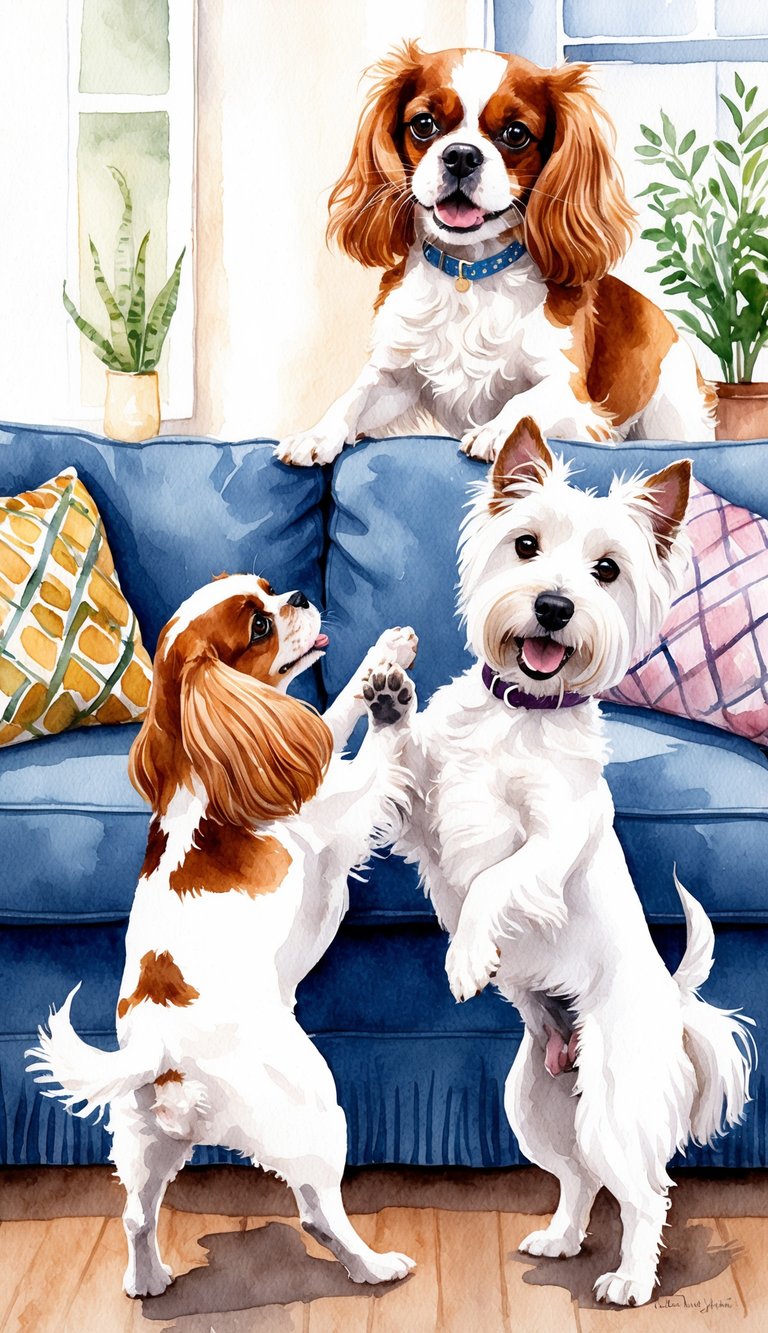
Picking the right dog depends a lot on your living situation. Space, noise tolerance, and your own experience matter more than you might think.
Living in Apartments vs Houses
Cavalier King Charles Spaniels handle apartment life really well. They’re small, calm, and don’t bark much.
A few toys and regular walks keep them happy, even in a small space. They’re about as easygoing as a Chihuahua or Pomeranian when it comes to space.
Westies are a bit more active and can be louder. They’ll bark at noises or people outside, which might annoy the neighbors.
Westies love having a yard to run in, but they can live in apartments as long as they get enough walks and playtime. Both breeds need daily attention, no matter where you live.
A yard gives a Westie more freedom, but Cavaliers usually adjust just fine to limited space.
Suitability for First-Time Owners
Cavalier King Charles Spaniels are great for first-time dog owners. They’re friendly, eager to please, and pick up training quickly.
Handling their behavior is pretty straightforward. Westies are more independent and can be stubborn.
They’ll try to be “the boss” if you don’t set clear rules. Patience and consistency matter a lot with Westies.
If you want a breed that’s a bit easier to manage, Cavaliers or even Chihuahuas are good picks. Westies aren’t as easy as a Pomeranian or Cavalier, but they’re rewarding if you’re up for the challenge.
Diet and Nutrition
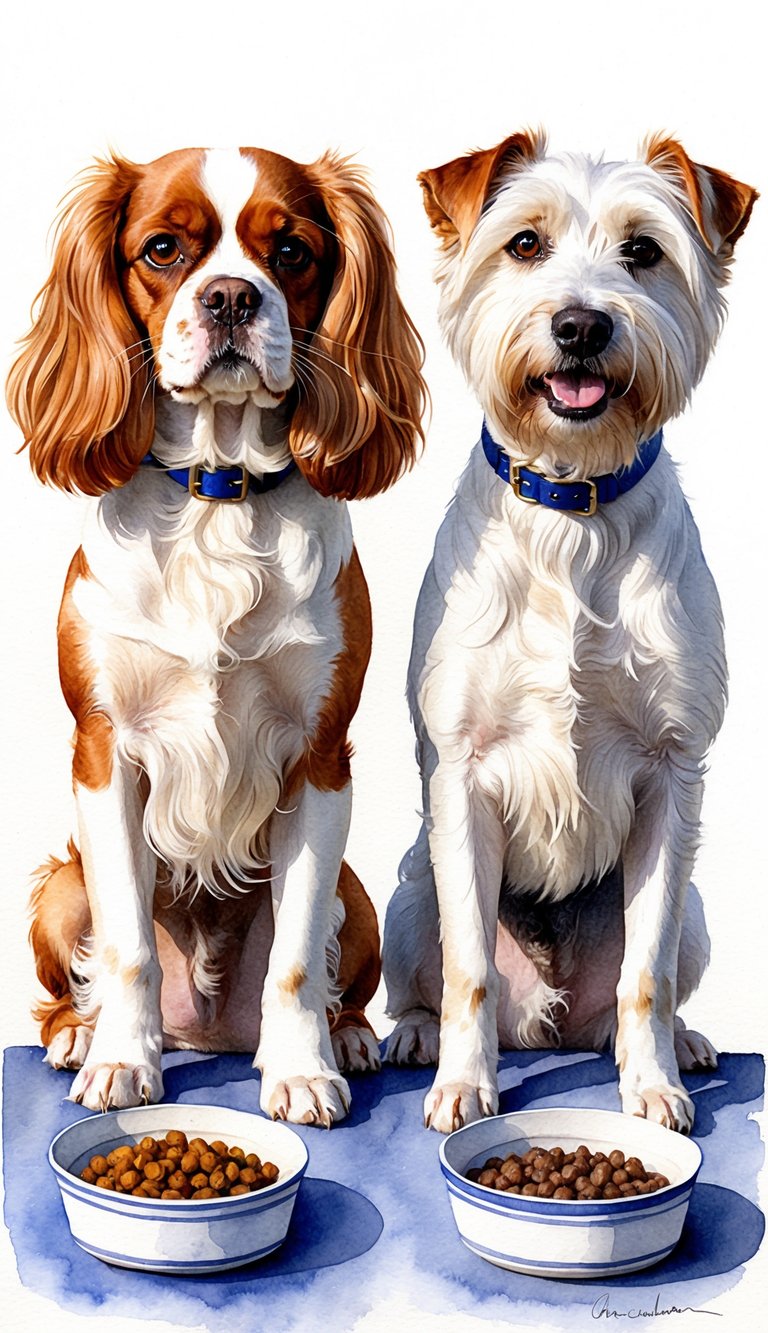
Cavalier King Charles Spaniels and West Highland White Terriers (Westies) both need balanced meals that fit their size, energy, and health quirks. Getting their diet right can help avoid weight gain and tummy troubles.
Ideal Diets for Each Breed
Cavalier King Charles Spaniel
These dogs have slower metabolisms and can pack on pounds if you’re not careful. Feed your Cavalier high-quality kibble or wet food with lean proteins like chicken or turkey.
Omega-3s from fish oil or flaxseed are great for their heart and joints. Try to avoid fatty foods—they don’t need them.
West Highland White Terrier
Westies are known for sensitive skin and stomachs. Single-protein or hypoallergenic foods work best.
Pick kibble or wet food with lamb or fish as the main ingredient. Grain-free diets sometimes help with itching or allergies.
Skip fillers like corn or soy—they can upset their stomachs.
A table comparing nutritional priorities:
| Breed | Key Protein | Avoid | Special Consideration |
|---|---|---|---|
| Cavalier | Chicken/Turkey | Fatty foods | Heart health (omega-3) |
| Westie | Lamb/Fish | Fillers, common allergens | Sensitive skin/stomachs |
Feeding Schedules and Tips
Both breeds do better with two balanced meals a day, not just one big meal. This helps avoid hunger spikes and can lower the risk of digestive issues like bloating.
For Cavaliers, keep portions measured to manage their weight. Treats shouldn’t go over 10% of their daily calories.
Always have fresh water available. If your Cavalier is really active or still a puppy, you might want to feed smaller, more frequent meals.
Westies need regular meal times to help with sensitive stomachs. Feed them at the same times every day, and avoid switching their food type or brand too often.
If you need to change their food, do it slowly over a week or so to avoid upsetting their stomach. If your dog eats too quickly, try a slow-feeder bowl to help prevent choking or vomiting.
Cost of Ownership
Owning a Cavalier King Charles Spaniel or a West Highland White Terrier means planning for both upfront and ongoing costs. Each breed brings its own quirks that can affect your budget.
Puppy Prices and Initial Expenses
Puppy prices depend on the breeder’s reputation, location, and whether the dog comes with registration papers. Cavalier King Charles Spaniel puppies usually cost $1,500 to $3,500 from a good breeder.
West Highland White Terriers (Westies) typically range from $1,000 to $2,500. Initial supplies—crate, bed, bowls, toys, collar, leash—can run $300 to $500.
First-year vet visits, vaccines, microchipping, and spay/neuter add another $300 to $700. If you’re buying from a breeder, make sure health screenings are included, especially for Cavaliers.
| Breed | Puppy Price | First-Year Vets & Supplies |
|---|---|---|
| Cavalier King Charles Spaniel | $1,500–$3,500 | $600–$1,200 |
| West Highland White Terrier | $1,000–$2,500 | $600–$1,200 |
Ongoing Care and Maintenance Costs
Yearly costs include food, vet care, grooming, and pet insurance. Cavaliers often need more vet visits as they get older, especially for heart and eye issues.
Plan for about $500 to $1,000 a year in medical costs. Westies usually have fewer big health problems, but allergies and skin issues can pop up.
Both breeds need regular grooming. Westies need professional trims every 6-8 weeks, which cost $40 to $60 per session.
Cavaliers need regular brushing at home and the occasional pro grooming, averaging $30 to $50 a session. Food costs about $20 to $40 a month for either breed.
Pet insurance is usually $20 to $40 a month, depending on what’s covered. Other routine costs include dental chews, waste bags, and annual vaccines.
Popularity and Breed Comparisons
Both the Cavalier King Charles Spaniel and the West Highland White Terrier have become popular pets thanks to their size, looks, and personalities. It’s always interesting to see how each breed stacks up against similar dogs.
Cavalier King Charles Spaniel Compared to Other Breeds
The Cavalier King Charles Spaniel is famous for its gentle, friendly nature and beautiful coat. Compared to a Bichon Frise, Cavaliers tend to be more laid-back and less energetic.
They bond closely with people and are usually very affectionate. Next to breeds like the Papillon or Cocker Spaniel, Cavaliers are less vocal and less independent.
They’re often more eager to please than a Lhasa Apso or Shih Tzu. Cavaliers have the classic lapdog charm you see in Pugs, but they’re usually more graceful and a bit taller.
If you’re considering a Cavalier or a Pembroke Welsh Corgi or Dachshund, keep in mind that Cavaliers are less stubborn. They get along well with kids and other pets, which makes them a solid choice for families.
West Highland White Terrier Compared to Other Terriers
The West Highland White Terrier, or Westie, stands out for its friendly yet confident personality. Compared to the Staffordshire Bull Terrier or Bull Terrier, the Westie is much smaller and has a softer look, but still brings that classic terrier boldness.
If you put the Westie next to the Airedale Terrier or Border Collie, you’ll notice Westies need less exercise. Grooming a Westie is easier than a Cocker Spaniel, though their coat still needs regular attention.
Compared to a Boxer or French Bulldog, Westies are usually a bit more active and alert indoors. They do best in homes with firm but gentle training and suit people who want a classic terrier without the big size or high energy of some working breeds.
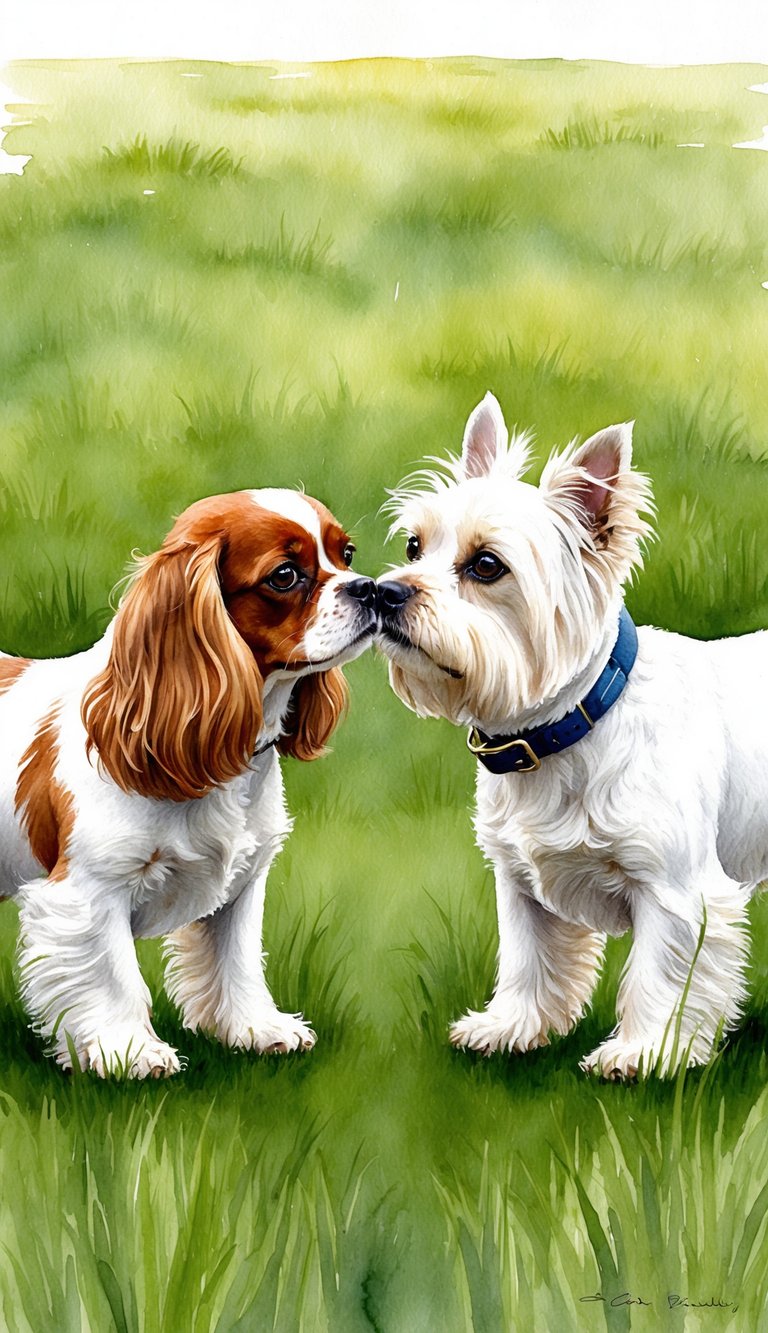
Picking between a Cavalier King Charles Spaniel and a West Highland White Terrier? It really comes down to your lifestyle and what you want in a dog.
If you picture yourself with a dog that loves to relax and soaks up family attention, the Cavalier might just be your buddy. They’re friendly and gentle with kids—honestly, it’s hard not to smile around them.
But maybe you’d rather have a playful, bold, and independent sidekick. In that case, the Westie could be a better fit. Westies are curious, and they definitely need more playtime and mental challenges.
Quick Reference Table
| Trait | Cavalier King Charles Spaniel | West Highland White Terrier |
|---|---|---|
| Size | Small | Small |
| Coat | Silky, medium length | Short, wiry |
| Exercise Needs | Moderate | High |
| Shedding | Moderate | Low to moderate |
| Personality | Gentle, affectionate | Bold, energetic |
Things to mull over:
- Grooming needs
- Typical energy level
- How much time you’ll have for training and play
Both breeds can make great pets. If you can, try to meet each breed in person before you decide—it just makes the choice feel a bit more real.

